It's the latest buzzword in our newspapers, on the radio and on television. We're told that it's set to revolutionize patient care but what exactly is 'e-Science' ?
'e-Science will change the dynamic of the way science is undertaken.'*
Today much medicine and biology is highly collaborative and inter-disciplinary. Science thinks BIG and it will get progressively bigger through distributed global collaborations enabled by the Internet. If there is one thing that typifies such collaborations it is requirement of being able to access and visualize huge amounts of data and that of course requires huge computing resources.
Thanks to the World Wide Web we can now sit at our laptops, press a few keys and gain access to information on Web pages written in html anywhere on the Internet. However, e-Science will require even more powerful infrastructure, scientists will need to access information stored in dedicated databases, remote facilities and computing resources as well. Grid architecture may well be the enabler of this 'virtual world' vision. In essence Grid is 'An infrastructure that enables flexible, secure, coordinated resource sharing among dynamic collections of individuals, institutions and resources.' **
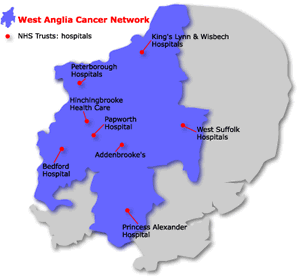 Currently the West Anglia Cancer Network (WACN) provides cancer services for a core population of 1.6 million and has an extended catchment area of 2-4 million. The Cancer Centre for the network is based at Addenbrooke's Hospital in collaboration with Papworth Hospital for patients with lung cancer. Six more Cancer Units at Bedford, King's Lynn, Peterborough, Hinchingbrooke, West Suffolk and Harlow Hospitals (together with the Cancer Centre at Addenbrooke's) serve the remainder of the region.
Currently the West Anglia Cancer Network (WACN) provides cancer services for a core population of 1.6 million and has an extended catchment area of 2-4 million. The Cancer Centre for the network is based at Addenbrooke's Hospital in collaboration with Papworth Hospital for patients with lung cancer. Six more Cancer Units at Bedford, King's Lynn, Peterborough, Hinchingbrooke, West Suffolk and Harlow Hospitals (together with the Cancer Centre at Addenbrooke's) serve the remainder of the region.
Figure 1: The WACN catchment area (left) Grid technology could dramatically improve delivery of patient care
It is clearly desirable to provide care as near as possible to the patient's home, just ask any cancer patient travelling the long journey back home on the train after a chemotherapy session. It is also desirable to maintain continuity of care. For example, there is a clear benefit for patients who require treatment at the Cancer Centre in Addenbrooke's (e.g. for radiotherapy) to have their treatment planned by the same Consultant they have seen at their nearest Cancer Unit. However, clinicians are currently travelling large distances to provide remote clinical services. Grid technology may be able to prevent the necessity for such travel and provide access to appropriate clinical information and images across the network thus dramatically improving the delivery of patient care. So how does it work?
Figures 2, 3 & 4 : 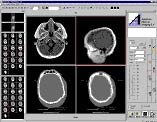 Communication and archiving of radiological images to support multi-disciplinary meetings for the review of cancer diagnoses and treatment, and real-time delivery of microscope imagery.
Communication and archiving of radiological images to support multi-disciplinary meetings for the review of cancer diagnoses and treatment, and real-time delivery of microscope imagery. 

The 'Telemedicine on the Grid' project (which is a joint project between the Cambridge eScience Centre, The University of Cambridge Department of Radiology and the West Anglia Cancer Network) aims to provide a secure infrastructure for advanced collaborative environments, using: multi-site video-conferencing, real-time delivery of microscope imagery and communication and archiving of radiological images to support multi-disciplinary meetings for the review of cancer diagnoses and treatment. The project also hopes to demonstrate the feasibility of remote access to computational medical simulations and the data-mining of patient record databases for improved clinical decision making.
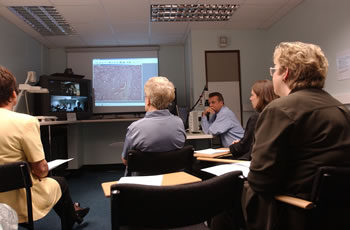 Figure 5 : A working multidisciplinary team meeting (left)
Figure 5 : A working multidisciplinary team meeting (left)
Lets focus on one area as an example; the NHS needs clinicians to participate in multidisciplinary team meetings (MDTs) in order to discuss the diagnosis and care plans of patients. Bringing together the necessary expertise and data can involve long travel times and is very wasteful of scarce consultant time. In partnership with the West Anglia Cancer Network, Macmillan Cancer Relief and Siemens Medical Systems, the Cambridge e-Science Centre is deploying integrated voice, video and data system technology to support MDTs. The aim is to provide an integrated package including voice, video and data from body scanners and pathology samples. The system must meet the needs of clinicians with a high quality data and video conferencing environment, and be simple to use. It must also be sufficiently general to be easily adapted to other medical image data, and open to the inclusion of electronic patient records. No mean feat! 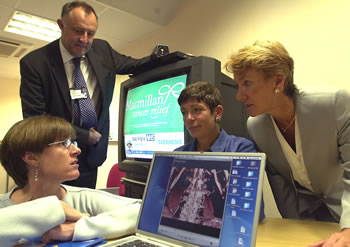
Figure 6: People looking at the system at the official launch (right). Improvements in West Anglia and potentially throughout the National Health Service: It is hoped that this project will demonstrate the capability of Grid technology to improve the delivery of patient care in the West Anglia region and so potentially throughout the National Health Service.
About the Authors: Dr. Andy Parker is a particle physicist, with research interests in new physics beyond the standard model, and is the Director of the Cambridge eScience Centre. Dr. Karen Smith is a neuroanatomist, and the Business Development Manager for Life Sciences at the University of Cambridge Corporate Liaison Office (CLO).
The Project Team: Dr Martin Graves (Dept. of Radiology), Dr Richard Ansorge (Cavendish Laboratory), Kate Caldwell (CeSC) and Mark Hayes (CeSC).
Quotes: * John Taylor, Director General of Research Councils Office of Science and Technology (from the e-Science Core Programme)
** Ian Foster and Carl Kesselman, inventors of the Globus approach to the Grid
 | 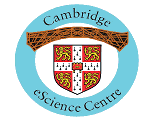 |
References
- Previous Playing The Odds
- Next Unpacking the Human Genome Project










Comments
Add a comment